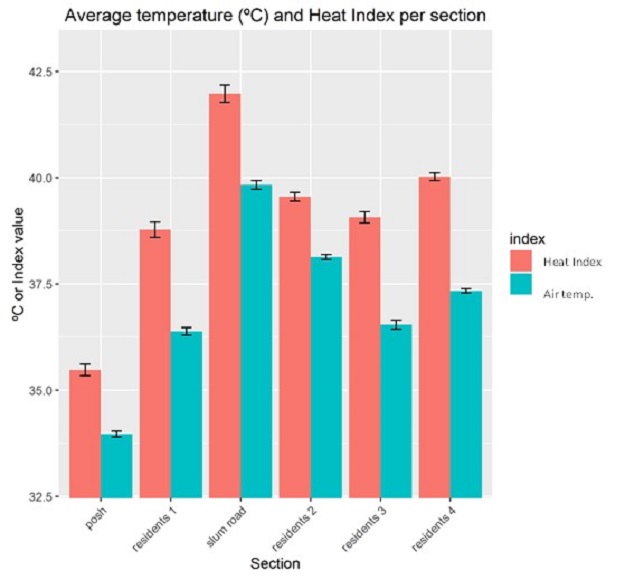Ganesh Gorti, Suruchi Bhadwal, The Energy Resources Institute, and Tanya Singh, Wageningen University
Every year Delhi hits the headlines of national news quite often than any other city in India. Smog, crime, pollution and extreme temperatures are more than often the top-stories. This year hasn’t been very different either, or not. The year opened with some drastic measures being announced by the Delhi government to bring down the thick smog that had blanketed the city. If that wasn’t the kind of New Year’s Delhites wanted, there was more surprise packed for them in the coming months.
Welcoming April were sweeping heatwaves that had set in over Southeast Asia, and had also covered a major portion of India, pushing some regions into drought like situations and resulting in farmer distress and human casualty. Delhi was no exception to this, coupled with its own microecosystem, for the metropolis it is, Delhi has been experiencing ravaging heat conditions up until late June.
It is during this period that the HI-AWARE team comprising of researchers from both The Energy and Resources Institute (TERI) and ALTERRA, had initiated a collaborative study to understand the extent to which heat conditions are experienced in the neighbourhoods of Delhi. The study also envisages understanding the current coping mechanisms being employed by residents in low and lower middle income groups to combat heat stress. To realize this, the team has employed on field, an Automatic Weather Station, followed by a self-assembled mobile Automatic Weather Station that is being taken on a pre-determined transect traversing through select neighbourhoods where indoor temperature and humidity loggers were installed inside (select) houses.
In order to cover thermal comfort differences across a spatial scale in the city, various weather parameters were measured once a week in the afternoons and evenings along a fixed path including different neighbourhood types (e.g. spacious green, low and high-rise building or heavily built residential areas). As air temperature, relative humidity, wind speed and solar radiation are measured, different thermal comfort or heat stress indices can be calculated. Figure 1 shows the measurement route for Delhi and highlights together with Figure 2 some selected neighbourhoods along the path.
 Figure 1: Thermal comfort measurements along a fixed path in South – East Delhi In Figure 2 spatial differences in air temperature and in the heat index are shown for an evening measurement conducted mid of May of this year. Next to these two thermal comfort indices the Universal Thermal Climate Index (UTCI), Wet Bulb Globe Temperature (WBGT) and the mean radiant temperature are measured as well (not shown here).The biggest contrast in this example can be seen between the ‘posh’ and ‘slum road’ neighbourhoods (=sections). Former is situated in a green open and posh residential neighbourhood of South Delhi (Golf Links) and latter is a small patch of informal houses next to a main road in East Delhi (Patparganj).
Figure 1: Thermal comfort measurements along a fixed path in South – East Delhi In Figure 2 spatial differences in air temperature and in the heat index are shown for an evening measurement conducted mid of May of this year. Next to these two thermal comfort indices the Universal Thermal Climate Index (UTCI), Wet Bulb Globe Temperature (WBGT) and the mean radiant temperature are measured as well (not shown here).The biggest contrast in this example can be seen between the ‘posh’ and ‘slum road’ neighbourhoods (=sections). Former is situated in a green open and posh residential neighbourhood of South Delhi (Golf Links) and latter is a small patch of informal houses next to a main road in East Delhi (Patparganj).
‘Residents 1, 2 and 3’ are located in heavily built areas (commercial and residential neighbourhoods) in which a mix of different socio-economic classes (from low to high-middle) live. The UHI is most prominent during night time, and the results indicate that the ‘posh’ green neighbourhoods are 6 degrees (°C) cooler at night compared to a socio-economically deprived neighbourhood, built next to a big concrete road. Next to informing on spatial thermal comfort differences due to modifications in land-cover, these preliminary results could shed an interesting light on socio-economic equity.
 Figure 2: Air temperature (°C) and heat index across a set of selected neighbourhoods in South–East Delhi
Figure 2: Air temperature (°C) and heat index across a set of selected neighbourhoods in South–East Delhi
It is hoped that the outcomes of this research activity will aid in understanding the issues related to urban heat island phenomenon and heat stress on human health and come up with a comprehensive adaptation strategies. This not only makes a citizen’s life heat-stress free, but comfortable and healthy.
On the other hand, the coping mechanisms undertaken by the locals were more or less to ensure fluid uptake, while there have been a few hard measures that some households had implemented, where the rooftops of these houses were layered with broken tiles and porcelain in order to reflect some sunshine back. Surprisingly, news articles had popped up in Late June where the state run Delhi Metro Rail Corporation (DMRC) had also soon picked up this idea and had touted it as an “energy conservation” adaptation measure to ensure passive cooling of their buildings.
Though marked by difficulties, in braving the gruelling heat to have got the indoor loggers installed before Delhi turned even more roasty, the research, from the initial findings is very promising and we, researchers at both TERI and Alterra, are looking forward to the interesting and policy relevant outputs from it.
